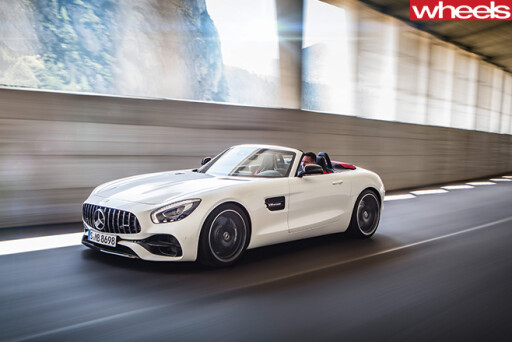
MERCEDES-Benz has expanded its AMG GT family with an open-top Roadster and a GT C model complete with a higher output version of the 4.0-litre twin-turbo V8.
The GT C gives a tantalising taste of a possible new “C” line to slot in above the AMG S models, bringing go-fast handling tweaks and more power.
The C moniker – Mercedes-AMG hasn’t said what the C stands for, although apparently it’s not “comfort” – is expected to spawn more models within a rapidly growing AMG portfolio.
AMG boss Tobias Moers told Wheels the GT C was about blending some of the technology and thinking in the GT R with a more comfortable road car.
“GT C is a more luxurious version, it’s more sophisticated,” said Moers.
 The GT C gets a 410kW/680Nm version of the 4.0-litre twin turbo V8, well up on the 350kW/630Nm and 375kW/650Nm produced by the same basic engine used in the AMG GT and AMG GT S.
The GT C gets a 410kW/680Nm version of the 4.0-litre twin turbo V8, well up on the 350kW/630Nm and 375kW/650Nm produced by the same basic engine used in the AMG GT and AMG GT S.
Yet its output is far enough below the recently revealed, track-focused GT R (430kW/700Nm) to ensure that road-going interpretation of the track-only GT3 is still king of the AMG GT kids when it comes to going fast.
However, the GT C benefits from the Nurburgring-led development of the AMG GT R in other areas.
 For example, the GT C picks up some of the dynamic smarts of the GT R, including active rear wheel steering; the rear wheels turn in the opposite direction to the fronts up to 100km/h and in the same direction above that speed.
For example, the GT C picks up some of the dynamic smarts of the GT R, including active rear wheel steering; the rear wheels turn in the opposite direction to the fronts up to 100km/h and in the same direction above that speed.
The C also gets the R’s electronically locking rear differential to aid traction when punching out of corners.
The GT C also gets some of the styling cues from the GT R, the most distinctive of which is the Panamericana grille with its vertical chrome slats. Behind that grille is an active aerodynamic system that can close vents to smooth the air flow when cruising.
 The rear wheel arches, too, are borrowed from the GT R, bringing another 57mm of width to the body and allowing for a wider track that spaces the rear wheels further apart.
The rear wheel arches, too, are borrowed from the GT R, bringing another 57mm of width to the body and allowing for a wider track that spaces the rear wheels further apart.
As with the GT S, the GT C uses 19-inch front wheels and 20-inch rears, although the rears on the GT C are 10mm wider, at 305mm, in an effort to better harness the extra power.
The GT C also picks up the AMG Ride Control suspension, which includes adaptive adjustable damping. It’s matched to the AMG GT R’s nine-stage traction control system developed with track use in mind.
For now, the AMG GT C is available exclusively in the Roadster body, which adds 55kg to the weight.
Blame that added bulk largely on the extra bracing to ensure the required body strength for its high-performance duties.
 The Roadster uses the same basic roof mechanism from the former AMG flagship, the SLS Roadster, with the ability to open or close in 11 seconds at speeds of up to 50km/h.
The Roadster uses the same basic roof mechanism from the former AMG flagship, the SLS Roadster, with the ability to open or close in 11 seconds at speeds of up to 50km/h.
Despite the extra weight, Mercedes-AMG quotes the same 4.0 second 0-100km/h for the GT Roadster and the GT Coupe that arrives in Australia late in 2016.
The GT C, on the other hand, uses its extra oomph to complete the 0-100km/h sprint in 3.7 seconds – 0.1 seconds faster than the GT S and 0.1 seconds slower than the GT R.
Moers told Wheels that a GT C Coupe was also in the works, and would be revealed late in 2017.
“There’ll be a coupe version of the GT C badge as well,” he said.
Despite the recent additions, the AMG GT family still has more room to expand.
As mentioned, a GT C Coupe is due late next year, and a Black Series is also in the works; expect to see that pinnacle of GT performance in 2018 or later.
Mercedes-Benz is also working on a Porsche Panamera-rivalling four-door version, so far known as GT4.

COMMENTS